The social map of bears
Bears are very good at managing social relationships at a distance by using their eyesight and sense of smell
As naturally solitary animals, bears need a great deal of space to live. Even though under these conditions meeting up is certainly not easy, bears nevertheless have a lot to say to each other.
They are not territorially exclusive animals in the sense that they tolerate the proximity of other individuals, but they defend what they consider to be theirs, whether it be food, a refuge area or a mate. This means they need to mark boundaries and leave warning signs to induce other competing bears to keep a distance. If they are obliged to share the same space, they prefer doing so with their own blood relatives. Related animals living in the same territory must therefore be able to recognise each other. Bears also have to breed, so males and females must be able to meet and, especially for males, to know which and how many rivals are in the vicinity. Juveniles in dispersion and females with cubs born that year need to play their cards early and astutely to defend themselves against aggressive adult males, so they need to know where, how and when to avoid them. How do bears manage to spatially define their social relationships without direct contact? They have developed the ability to leave olfactory and visual clues and these can convey a surprising amount of information to others. How does this communication and marking work? Bears leave odorous footprints and mark trees, trunks on the ground and rocks by rubbing against them, leaving bite or scratch marks or scraping the ground.
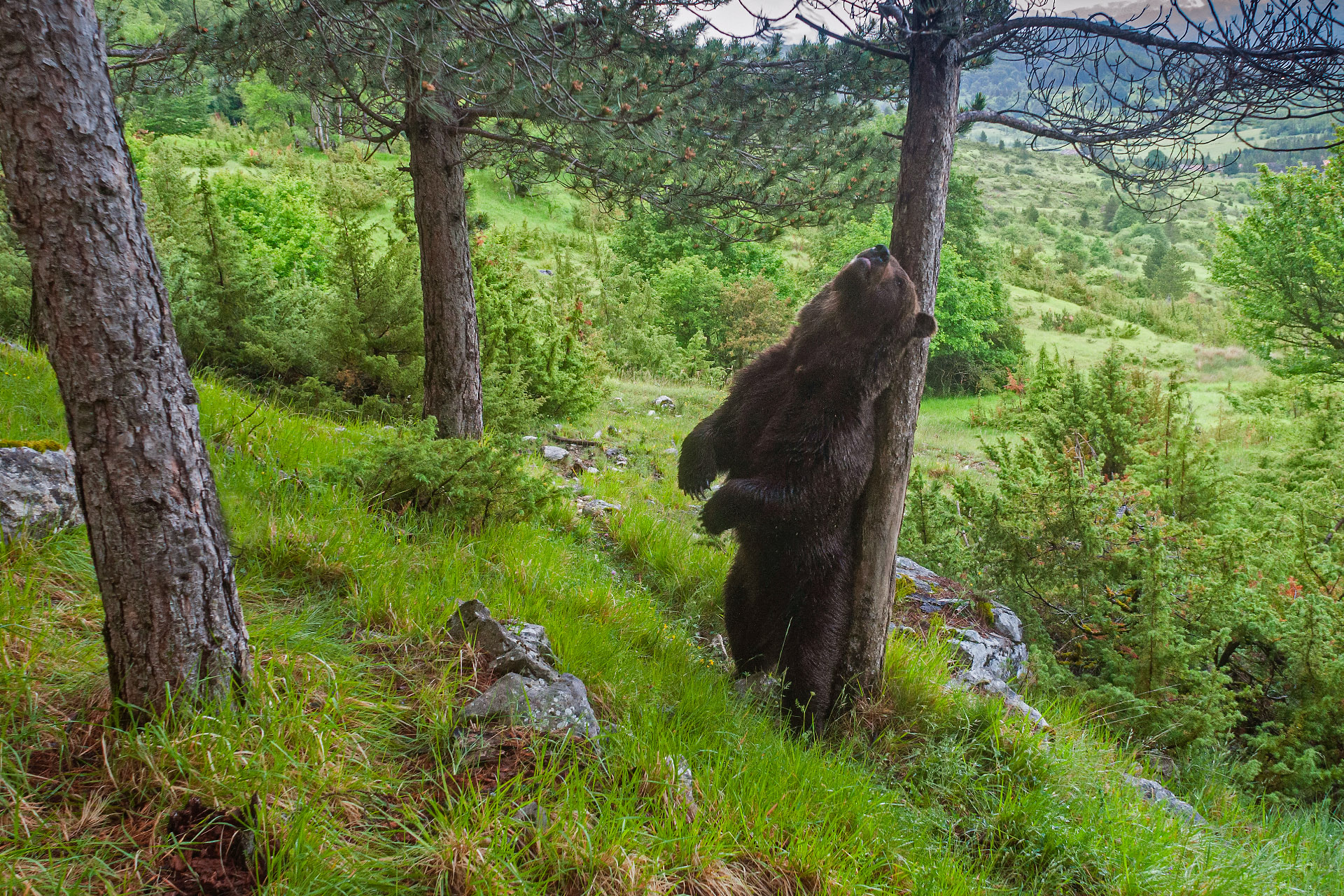
And adult male Apennine bear during the mating season rubs its back against the bark of a young pine tree.
It’s mid-June and I’m walking up the rocky bed of a dry stream. From there, a mule track winds its way into the heart of the green, leafy beech forest. Where the track branches off, I come across a large beech tree that watches over the path. I feel a shiver run down my spine, but my lips curve into a smile of satisfaction. Four diagonal furrows at a height of about one and a half metres have recently left the pinkish flesh of the wood exposed and it now stands out against the grey-green tones of the bark with its moss and lichen. Without even realising, I reach out with my right hand and brush my fingers over that three-dimensional signature. With almost intimate gestures, I observe and sniff every inch of the bark, searching for possible clues. Undoubtedly he had approached the tree and reached out his neck to sniff attentively, seeking the scent of his fellow bears. Then he must have stood up on his hind legs, digging in his feet and stretching his back to a height of almost one and a half metres. That’s where the last hairs are. The splinters of bark must have creaked, crushed and shaken by that weight and that force. Then he would probably have turned round, hugging the trunk and scratching it with his right paw. That mark would always be there. It would last for decades, until either the tree fell or the harsh weather detached the bark completely . Anyone passing by, man or other animal, would notice it and know who was boss in those parts.
Bruno
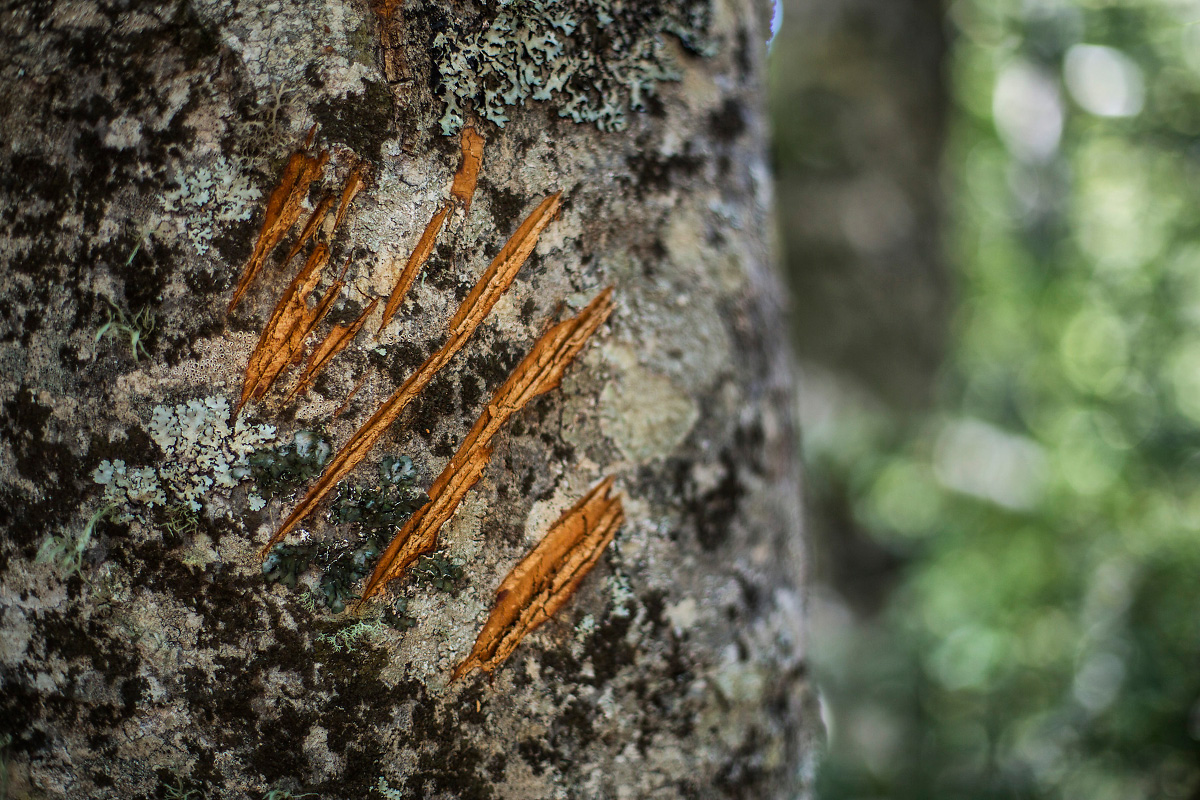
Bears mark trees, a beech in this case, by peeling back the bark with their powerful claws.
For a bear, sniffing a tree is like going to the registry office. In practice, sniff by sniff, each bear creates its own “bank of smells” with all the related information, valuable to either prevent or encourage certain encounters.
This type of communication is very effective, because bears have a sense of smell 2000 times better than humans. They live and survive by “following their nose”. For example, polar bears, the most strictly carnivorous of bears, move at night following the winds to intercept and locate their prey. But bears also use their sense of smell to become skilled “detectives”. With just a few sniffs of the ground or a particular tree, they can build up a true “identikit” of the other bears that have passed there before them. And of course, if they want, they can also leave their own mark. It seems that each bear has its own identifying smell and, as we’ll see, by playing with how, when and where they leave their odour, they can convey many other messages, such as size and social status.
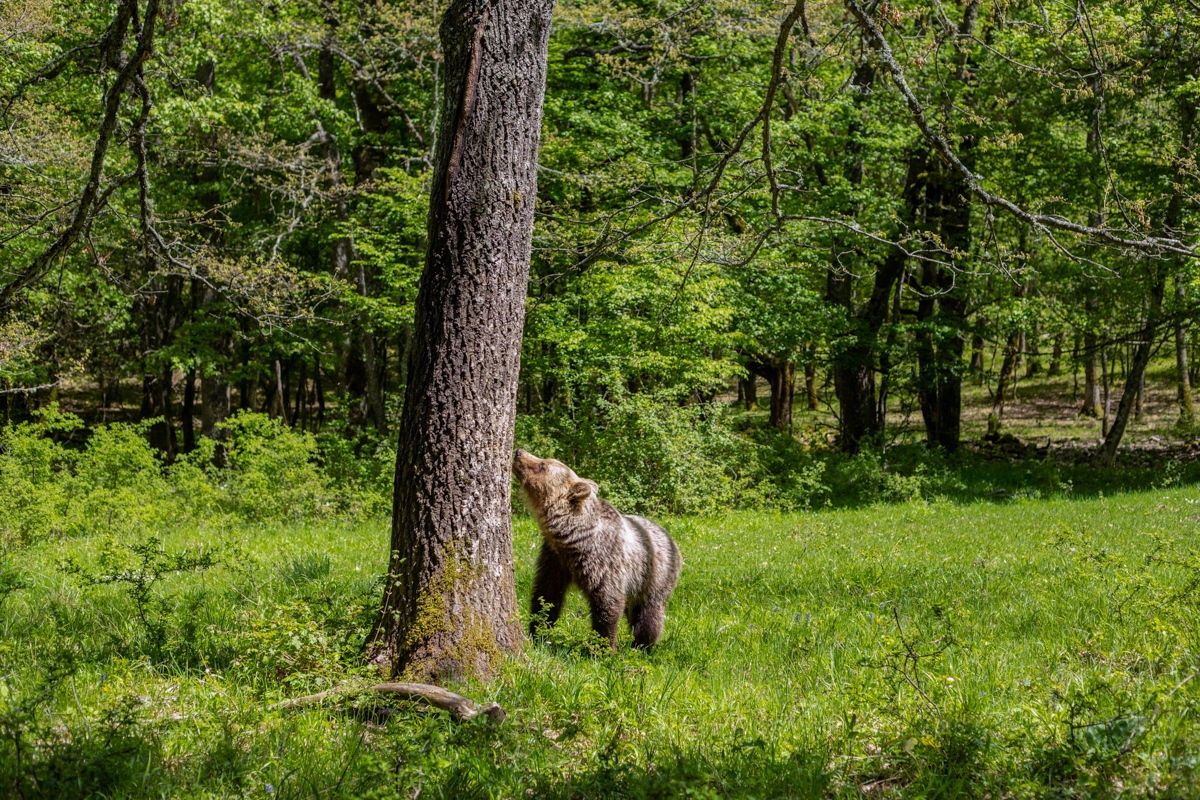
An Apennine bear smells the bark of an oak tree used as rubtree. To detect and differentiate odours, a bear curves its upper lip and extends its muzzle. This movement facilitates the transfer of odorous chemicals to their vomeronasal or Jacobson’s organ.
Researchers have recently confirmed that bears can actually recognise each other chemically. Brown bears have numerous apocrine and sebaceous glands (able to produce odorous secretions) connected to the hair bulbs all over the skin covering their toes. Under the sole of the foot, there are other “exocrine” glands that produce a secretion similar to sweat. According to scientists, these glands produce a cocktail of fatty, liquid and volatile secretions that can last up to several months. The secretions produced by these glands can contain up to twenty-six different organic compounds, six exclusive to males. In fact, it is mainly the adult males that leave a scent trail and they do so most frequently during the breeding season to warn rivals or as an amorous invitation to future mates. Some of the components identified have also been found in the secretions of primates, including humans, and others even in the pheromones produced by ants and termites for orientation and recognition.
A male never misses a step as he approaches a marking site such as a tree. He goes over and over his own footprints, pressing his foot down with a slight twist to create deeper and deeper depressions. And that is where he leaves his identity.
The bears dance a real twist in close contact with the tree bark. Standing on two legs, or sitting on their rump, they rub their backs and bellies. But they can also do so on all fours and on their side. Lying down or curled up. If they find a branch within reach of their paw, they hang on to it and bend it down with force, rubbing their backs convulsively up and down. Each has his own choreography. Adult males do their utmost to rub themselves ever higher, showing off their physique to all passers-by.
When a male bear visits a rub tree, he first sniffs the base where there are depressions left by the paws of other bears, then he too leaves his mark with a little twist of his foot, sniffs the bark and finally rubs against the tree. That’s how he leaves his identity.
More than 180 trees used by bears as marking sites have been located in the Abruzzo, Lazio and Molise National Park. Some researchers claim that the functional role of marking can vary over time and according to the particular phase in the bear’s life cycle. In practice, each tree has many roles and is used by bears to convey or receive different messages depending on who is passing by, the season and the location.
Both sexes indulge in rubbing, but the adult males do so more frequently during the breeding season from April to July. In this way, the trees are used to attract and locate possible mates and, particularly for males, to signal their reproductive dominance. Females with cubs and sub-adults rarely rub, as they aim for a lower profile. On the other hand, they are equally interested in investigating the marks on the so-called “rub trees”. Especially during the mating season, this would help them avoid males and other conflict situations. But bears also rub outside the breeding season and males in particular seem to use this behaviour to exert control over a territory and adult females throughout the year. The same marking activity is used by adult males and females to exert dominance in areas particularly rich in food and which may thus attract other bears who compete indirectly. Based on the freshness of the markings, lower-ranking individuals can assess whether or not to take advantage of a certain time window to access the same resources. In the Apennines, alpine buckthorn scrub is one example of these particularly attractive areas.
Researcher Melanie Clapham, from the Department of Geography at the University of Victoria in British Columbia, talks about the results of research on the social behaviour of bears.
How the bears leave their mark is anything but random and they take great care when selecting the areas and trees on which to rub. They prefer trees located at transit points: roads, paths, crossroads, bends, passes, ridges or areas of transition from one environment to another. All places where the marking is most likely to be intercepted by another bear. In general, the characteristics of the trees used generally seem to favour both the pleasure of scratching (such as convenience or effectiveness) and the visual or olfactory retention of the marking. The favourite are sloping trees with a wrinkled knotty bark and generally large diameter. However, sometimes thin and completely anonymous trees are targeted because they are located at very strategic points, such as the junction of several paths. In general, the bears choose one of the species that predominate in the given area. In the Park, more than 60 per cent of “rub trees” are beeches with diameters ranging from 10 to 140 centimetres, followed by oaks, conifers and maples.
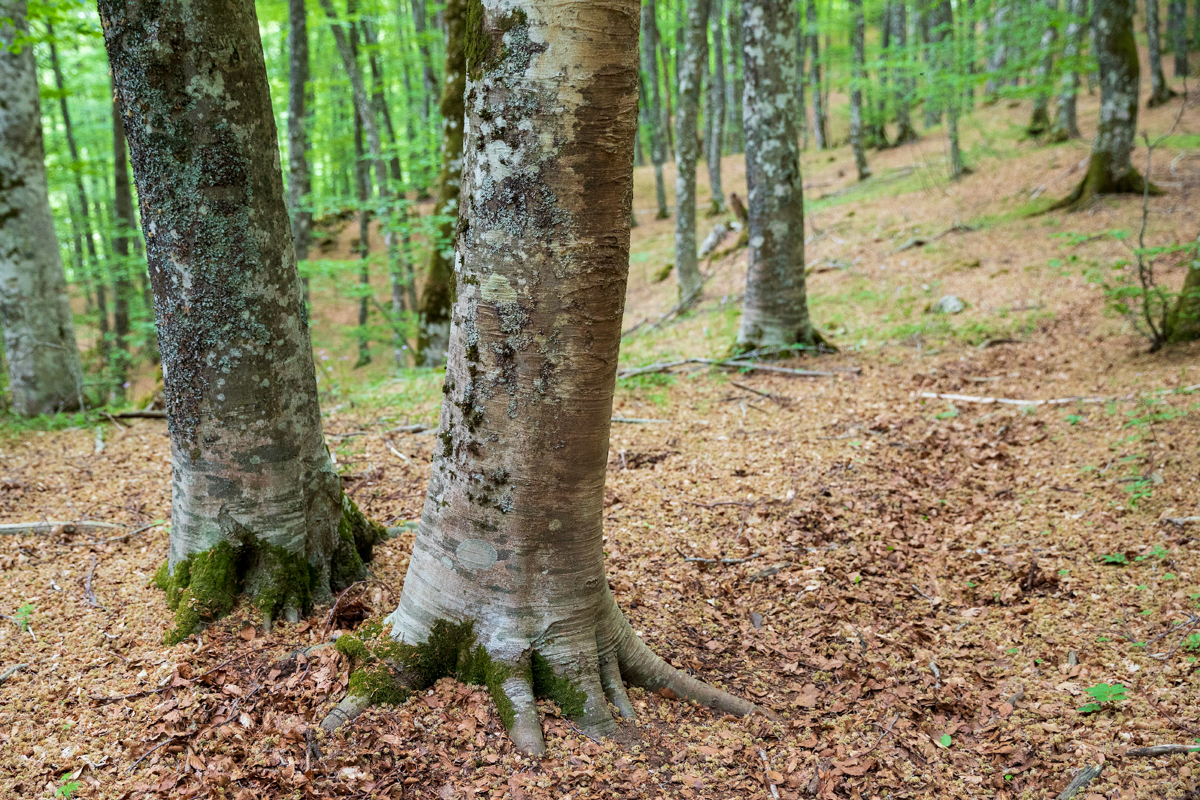
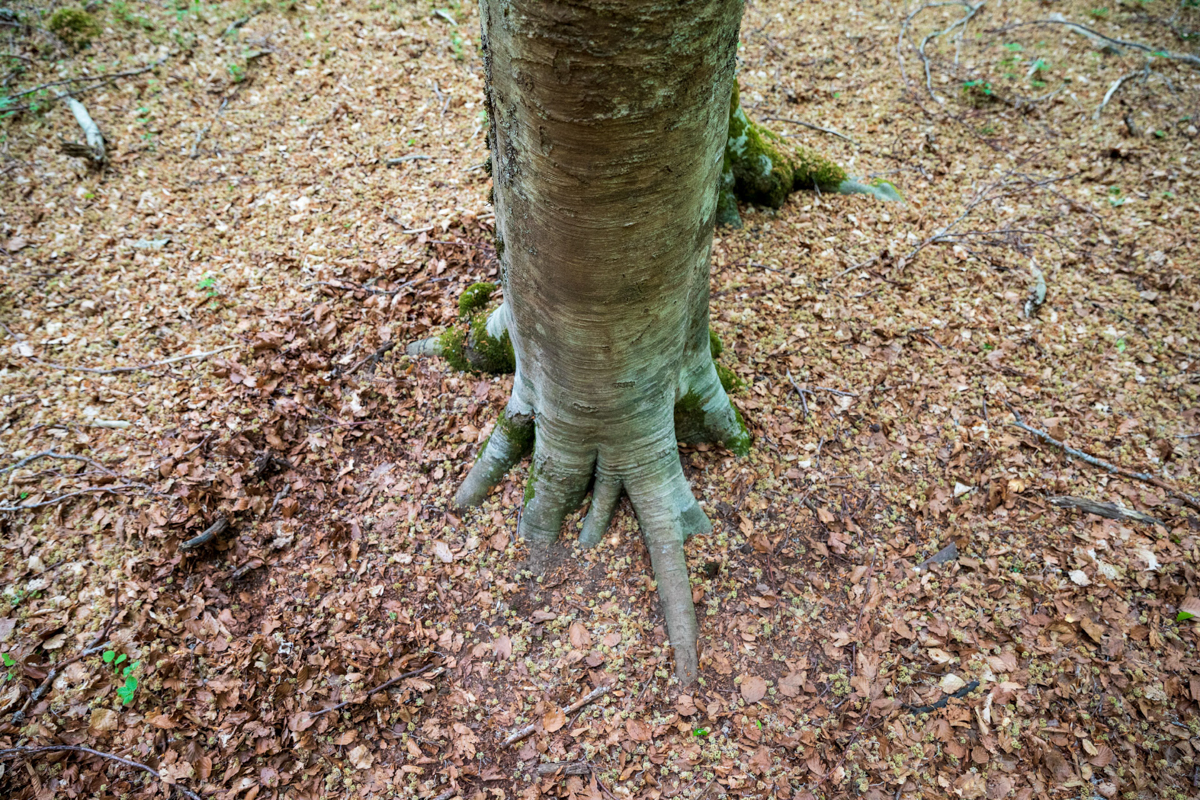
Bears choose characteristic trees and places to leave their signs, usually where there is the greatest likelihood of other animals coming across them.
Bears also direct their “rubbing” not over the entire surface of the trunk, but over the most prominent and convenient parts, always using the same route to reach them. This creates paths followed by one or more bears every year, always in the same way. Some trees can be considered genuine totems. These can be recognised by their worn bark and the absence of vegetation at the base of the trunk, the so-called “platform”, where the bear presses down on its paws or body to rub itself,
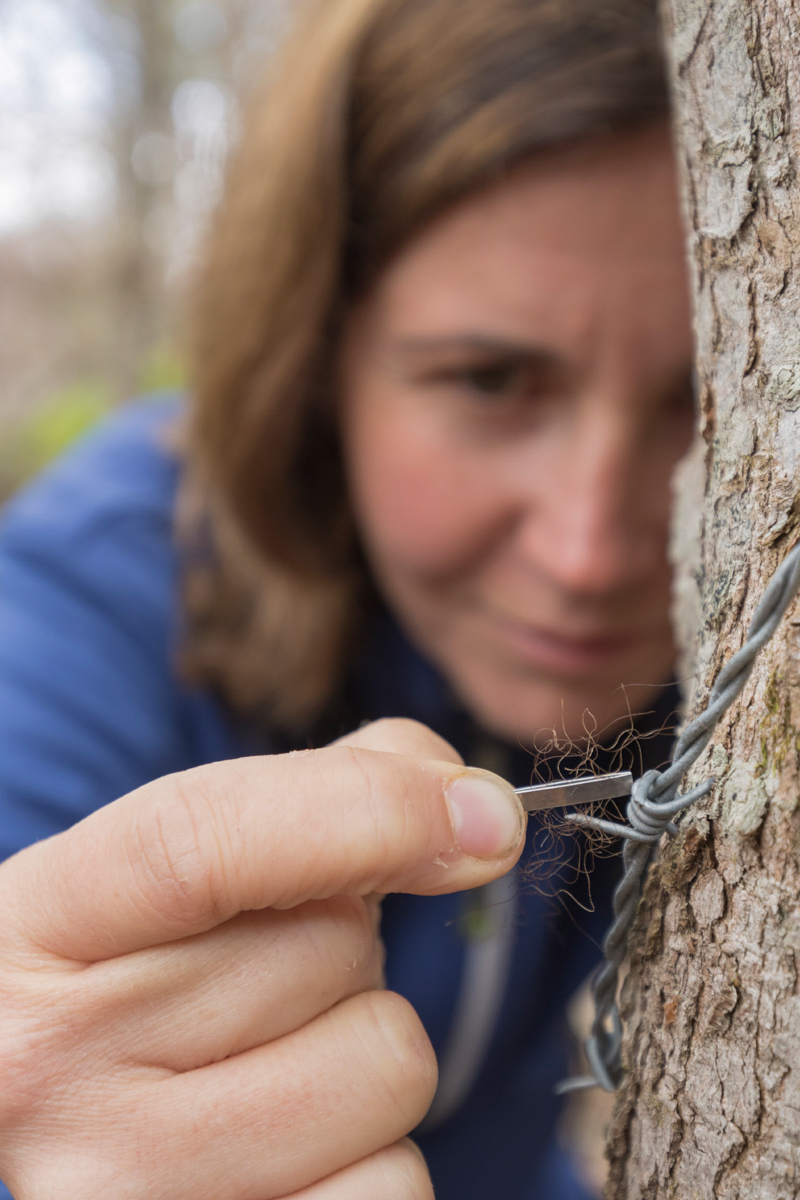
Using genetic survey techniques, it is possible to identify individual bears from their hair. A researcher collects a sample from barbed wire specially fixed on a rubtree to retain the hair without harming the animal.
In 2011, as part of a study to estimate the number of bears present in the Park through non-invasive genetic monitoring techniques, 100 “rub trees” were equipped with barbed wire. This study made it possible to identify the bears rubbing on the trees by collecting and analysing their hairs. The study gathered a great deal of evidence confirming the communicative and marking function of the “rub trees” in the Park. The analyses also showed that both males and females mark trees, although more than 80% of the hairs collected were attributable to males. The peak use for both sexes is between June and July. Males and females continue rubbing until the beginning of autumn, although with less intensity than during the breeding season. In particular, use of the “rub trees” peaked in September, when the bears congregate in the buckthorn scrub and probably compete for access to the best feeding sites.
The probability with which males and females mark trees varies over the months and between the sexes.
A recent study in Alberta, North America, found that, regardless of gender, the individuals who scratch the most (more frequently and on more trees) are also those who will have the most opportunities to mate (and with different partners) and have the most cubs. From the odour left on the trees, the females in particular could obtain useful “clues” to identify not only the most genetically valuable males, but also those that are not related. In the Park over the years, a number of “rub trees” have been seen to be used exclusively by one or more individuals, suggesting that the bears divide up the space and that some exercise dominance or control over others throughout the year.
Duels and courtships through rubbing
The lives of many animals revolve around a tree
Rub trees are a hub for communication between many species. Territorial animals mark them to exercise their right of ownership, while prey animals examine them to avoid predators
The use of scent markings as a communication system is widespread among mammals. Carnivores produce many sources of odour, ranging from glandular secretions to elements such as saliva, excrement and urine. In particular, canids such as wolves and foxes, together with mustelids such as badgers, mark their territory with these odours, both asserting their “ownership” and as a courtship technique. These animals also include rub trees among their marking sites. In the case of prey animals such as red and roe deer and wild boar, rub trees can provoke a real aversion and flight reaction. When they come across them, these animals behave as if faced with danger. They sniff, go on the alert and flee if the odour of a wolf or bear is recent.
It would be wonderful to get inside a bear’s head for a moment and understand how it perceives its surroundings: how and what it learns along the way. And from whom? Perhaps bears are faced with a network of paths and routes in which they learn to move around by smelling the lives of the bears that preceded them.
K. Noyce
As the bears move about, they create maps of scent paths that create “involuntary” flashmobs, where the bears unwittingly find themselves visiting the same places at the same times.
Bears are very habitual in their choice of routes. Over the years, bear after bear and step by step, a complex network of customary scent trails and paths forms in which each bear can freely orient itself. A ten-year study in Minnesota showed that black bears migrate in late summer to areas rich in acorns and crops, travelling up to tens of kilometres. The bears spend about six weeks there feeding, then in most cases, return to their place of departure and hibernate. Some areas can be considered traditional, as they are visited by the same bears for several years; others may be visited by several bears in the same year, although never at the same time in the same spot. Migration routes change every year in intensity and direction, explained by natural fluctuations in the productivity of fruit-bearing plants. The surprising thing is that every year the bears coordinate their movements, following each other at a distance along the same routes, or even associating.
“In mid-April we went back to a valley with precipitous slopes and large centuries-old trees on one side. The impervious nature of the terrain had probably made logging difficult and those extraordinary plants had thus managed to survive to a ripe old age. A month earlier, in the late afternoon, we had spotted a bear, probably just out of hibernation, moving slowly and curiously through that primordial landscape. It emerged from the forest and clambered up onto a rocky rampart, then “dived” headfirst into a steep gully, sliding on the dead leaves. This time, at 17:00, with the first leaves on the trees and against a background of hundreds of birdsongs, another bear much larger than the first appeared in exactly the same spot among the trees, then followed exactly the same path as the first bear, making the same movements. We knew that bears often follow each other, but watching two different animals, a month apart, behave and move identically through that maze of boulders, overhanging ledges and walls amazed us. It is this respect for tradition that makes bears both fascinating and so extremely vulnerable.”
Bruno e Umberto
By marking their own paths, bears have thus evolved an effective way of passing on knowledge and learning at a distance. Bears learn from each other, following each other at a distance. For example, crossing new territory can be very risky for a young bear if it fails to find food. However, by following in the footsteps of the most experienced, it will be able to quickly construct a cognitive map of the territory it is crossing with all its environmental and social components. Adult males play a key role as “teachers of orientation”. Thanks to their extensive movements, their knowledge of the territory is unparalleled and they can pass this on to the entire population. This same mechanism would also seem to facilitate the recolonisation of new areas by large territorial and social carnivores such as the wolf. For example, in Yellowstone Park, after an absence of 70 years, the reintroduced wolves used the same routes and marking sites as their predecessors.
Bears have innate communication skills: they can listen, observe and relate even at a distance. When young bears reach two years of age, they spend some time hardly ever stopping to rest. By looking around, they learn about the physical and social landscape of their future.

